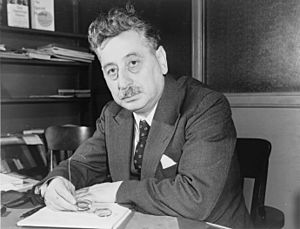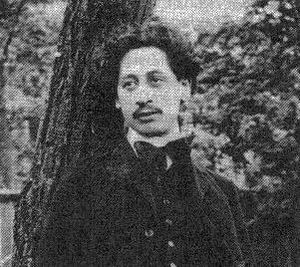Sholem Asch facts for kids
Quick facts for kids
Sholem Asch
|
|
|---|---|

Sholem Asch, 1940
|
|
| Born |
Szalom Asz
1 November 1880 Kutno, Congress Poland, Russian Empire
|
| Died | 10 July 1957 (aged 76) London, England
|
| Nationality | Polish-Jewish |
| Other names | Szalom Asz, Shalom Asch, Shalom Ash |
| Occupation |
|
Sholem Asch (Yiddish: שלום אַש, Polish: Szalom Asz; 1 November 1880 – 10 July 1957), also known as Shalom Ash, was a famous writer. He was a Polish-Jewish novelist, playwright, and essayist. He wrote in the Yiddish language and later lived in the United States.
Contents
Sholem Asch: A Famous Writer
Sholem Asch was born Szalom Asz in Kutno, Congress Poland. His father, Moszek Asz, was a cattle-dealer and innkeeper. His mother was Frajda Malka. Sholem was one of ten children his parents had together. His father was known for being very kind and giving money to people who needed it.
Early Life and Education
Sholem Asch grew up in a Hasidic family. He received a traditional Jewish education. His parents hoped he would become a rabbi. They sent him to the best religious school in town. There, he spent most of his childhood studying the Talmud. He also read the Bible and the Haggadah on his own.
Sholem grew up in a town where most people were Jewish. He thought Jews were the majority everywhere. In Kutno, Jews and non-Jews usually got along well.
Discovering New Ideas
As a teenager, Sholem learned about new ideas. These ideas were part of the Jewish Enlightenment, called the Haskalah. He secretly read many non-religious books at a friend's house. This made him feel too worldly to become a rabbi.
When he was 17, his parents sent him to a nearby village. He worked there as a Hebrew teacher. Later, he moved to Włocławek for a more liberal education. He earned money by writing letters for people who couldn't write. In Włocławek, he loved the works of the writer I. L. Peretz. This is also where he started writing. He began by writing short stories in Hebrew. These early writings later helped start his career.
Becoming a Professional Writer
In 1899, Sholem moved to Warsaw. There, he met I. L. Peretz and other young writers. At first, Asch wrote in Hebrew. But Peretz convinced him to switch to Yiddish.
Asch became well-known in 1902. This was after his first book of stories, In a shlekhter tsayt (In a Bad Time), was published. In 1903, he married Mathilde Shapiro.
Famous Works and Plays
In 1904, Asch released A shtetl. This book showed a peaceful picture of traditional Polish-Jewish life. In 1905, his play Tsurikgekumen (Coming Back) was released. This marked the start of his very successful career as a playwright.
He wrote the play Got fun nekome (God of Vengeance) in 1906. It opened in Berlin in 1907 and was very popular. It was translated and performed in many European languages.
The play came to New York City, United States in 1907. It was later staged on Broadway in 1923. However, its run was cut short. The cast and producer were accused of breaking a state law. After a long legal fight, the conviction was overturned. In Europe, the play was translated into many languages, including German, Russian, and Hebrew.
In 1908, Asch attended the Czernowitz Conference. This conference declared Yiddish a "national language of the Jewish people." He traveled to Palestine in 1908 and the United States in 1910.
Life in America and Europe
In 1914, Asch and his family moved to the United States. They wanted to find safety from the violence in Europe. They lived in New York City and then settled in Staten Island. In New York, he started writing for Forverts. This was a popular Yiddish newspaper. It gave him income and a group of intellectual friends.
Asch became very involved in public life. He helped with efforts to help Jewish war victims in Europe. He was a founder of the American Jewish Joint Distribution Committee. After terrible events in Lithuania in 1919, Asch visited the country. He was deeply affected by the terrible things he saw. His book Kiddush ha-Shem (1919) tells about the Chmielnicki Uprising in the 1600s. In 1920, he became a naturalized citizen of the United States.
Travels and Later Writings
Asch returned to Poland in 1923 and often visited Germany. He later moved to Bellevue, France. He continued to write regularly for Yiddish newspapers in the US and Poland. In Bellevue, he wrote his trilogy Farn Mabul (Before the Flood). This series describes Jewish life in Saint Petersburg, Warsaw, and Moscow in the early 1900s.
Asch loved to travel. He took many trips to the Soviet Union, Palestine, and the United States. He admired painters and became friends with artists like Marc Chagall.
Asch was a celebrated writer during his lifetime. In 1920, a committee published a 12-volume set of his collected works. In 1932, he received the Polonia Restituta award from Poland. He was also made an honorary president of the Yiddish PEN Club.
In 1930, Asch was very famous. He moved to Nice, France. He then returned to Poland to research his next novel, Der tehilim-yid (Salvation). He later built a house outside Nice called "Villa Shalom."
His next book, Bayrn Opgrunt (1937, translated as The Precipice), is set in Germany. Dos Gezang fun Tol (The Song of the Valley) is about Jewish pioneers in Palestine. This book reflects his visit to that region in 1936. In 1939, he returned to Villa Shalom for the last time. He left Europe for the United States just before World War II.
Controversial Works and Later Years
In the US, Asch lived in Stamford, Connecticut, and then Miami Beach. He wrote a trilogy of books that caused controversy among Jewish readers. These books were The Nazarene, The Apostle, and Mary. They were about figures from the New Testament. Many Jewish readers felt he was promoting Christianity.
Asch always said he was proudly Jewish. He wrote the trilogy to help Jews and Christians understand each other better. However, his longtime employer, the Yiddish newspaper Forverts, stopped publishing his work. They also openly criticized him. He then started writing for a communist paper, Morgen frayhayt. This led to him being questioned by the House Committee on Un-American Activities.
In 1953, a book called The Christianity of Sholem Asch was published. It strongly criticized Asch's trilogy. Because of this book and the McCarthy Hearings, Asch and his wife left the US in 1953. They then divided their time between London, Europe, and Israel.
Death and Lasting Impact
Asch spent his last two years in Bat Yam near Tel Aviv, Israel. He died in London while writing at his desk. His funeral in London was small. His house in Bat Yam is now the Sholem Asch Museum.
Most of his large library, including rare Yiddish books and his own writings, is kept at Yale University. While some of his works are not widely read today, his best books are still important in Jewish and Yiddish literature.
His sons were Moses "Moe" Asch, who founded Folkways Records, and Nathan Asch, also a writer. His great-grandson, David Mazower, is a writer and journalist.
What Inspired Sholem Asch
Many of Asch's characters were inspired by his own father. Sholem learned many of his ideas from his father. These included his love for people and his hope for peace between Jews and Christians. He said his father's faith was about "love of God and love of neighbor."
Asch often wrote about two types of characters: the very religious Jew and the strong worker. This came from his family. His brothers worked with farmers and butchers. They fit in with the strong, outdoor Jews of Kutno, which Asch was proud of. His older half-brothers, however, were very religious Hasidim.
One of Asch's main goals was to describe Jewish life, both in the past and present. He always put Jewish people at the center of his stories. He also showed how Jews related to the world around them. Some of his common themes were: faith, goodness, and generosity. He was fascinated by Christian violence but also inspired by Jewish strength and survival.
Asch was interested in many different cultures and the people he met. His stories can be grouped into three main types:
- Stories and novels about Jewish life in Eastern Europe (mostly Poland).
- Stories and novels about Jewish life in America.
- Five biblical novels: two about figures from the Hebrew Bible and three about figures from the New Testament.
He also wrote about the Holocaust and modern Israel. His writing style mixed different ideas, like romanticism and realism.
See also
 In Spanish: Sholem Asch para niños
In Spanish: Sholem Asch para niños


